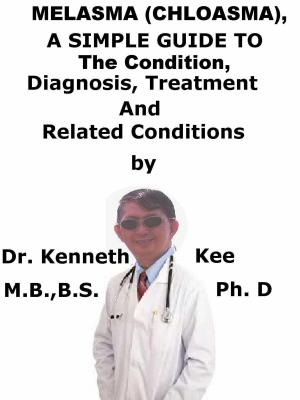Pancytopenia, A Simple Guide To The Condition, Diagnosis, Treatment And Related Conditions
Nonfiction, Health & Well Being, Medical, Specialties, Internal Medicine, Hematology| Author: | Kenneth Kee | ISBN: | 9781370374076 |
| Publisher: | Kenneth Kee | Publication: | July 10, 2017 |
| Imprint: | Smashwords Edition | Language: | English |
| Author: | Kenneth Kee |
| ISBN: | 9781370374076 |
| Publisher: | Kenneth Kee |
| Publication: | July 10, 2017 |
| Imprint: | Smashwords Edition |
| Language: | English |
Pancytopenia is a deficiency of all types of blood cells, including white blood cells, red blood cells, and platelets.
1. Anemia: hemoglobin < 13.5 g/dL (male) or 12 g/dL (female).
2. Leukopenia: total white cell count < 4.0 x 109/L. Decrease in all types of white blood cells (revealed by doing a differential count).
3. Thrombocytopenia: platelet count < 150×109/L.
The disease is marked by a poor appropriate and effective T cell activation that results in a raised hemophagocytic activity.
The T cell activated macrophages enclose erythrocytes, leukocytes, platelets, and their progenitor cells.
Such finding is frequent in the syndrome, which is also referred to as hemophagocytic lymphohistiocytosis (HLH).
Together with pancytopenia, HLH is characterized by fever, splenomegaly, and hemophagocytosis in bone marrow, liver, or lymph nodes.
It happens when the body cannot produce enough blood cells because the bone marrow stem cells that develop blood cells do not function normally.
Pancytopenia has general effects on the entire body by leading to oxygen shortage as well as disorders with immune function.
Aplastic anemia is a medical disease that indicates a reduction in production of all types of blood cells (pancytopenia) but the cells seen are normal in blood film and bone marrow.
Blood cancers like leukemia may show reduction in production of all types of blood cells (pancytopenia) but the cells seen are blast cells in the blood film or bone marrow.
The difference between pancytopenia and aplastic anemia is that pancytopenia is a blood finding while aplastic anemia is a disease showing pancytopenia but the cells seen are normal in blood film and bone marrow.
Pancytopenia happens in two forms:
1. Idiopathic, in which the cause is not identified
About 50% of all pancytopenia cases are idiopathic.
2. Secondary, often is caused by environmental factors such as medicines, toxins and cancer treatment.
Cancers by itself can cause pancytopenia but there are also blast cells in the blood and bone marrow
Pancytopenia may form slowly over time or suddenly, and it can continue in a range of ways.
Symptoms of pancytopenia can be bleeding, easy bruising, fatigue, shortness of breath, and weakness.
The reduction in white blood cells, which are affected in the body’s defense, or immune, system, also results in a higher risk of infection.
The disorder is normally diagnosed by a blood test to check any decrease in blood cell count.
A biopsy of the bone marrow is also done to make sure that the symptoms are not occurring from any other disorder like leukemia, anemia or thrombocytopenia
Treatment:
1. In very mild cases of pancytopenia, treatment may not be needed.
2. In moderate cases, blood transfusions may help recover blood cell counts;
The blood transfusions may become less effective over time.
3. In severe cases, treatments such as bone marrow transplant and stem cell therapy may be needed to recover the ability of bone marrow to produce blood cells.
Such treatments are normally effective in younger patients, but older patients may also need the use of immunosuppressant drugs or drugs that stimulate the bone marrow.
In cases linked to environmental factors, pancytopenia may recover on its own when the precipitating factor is eliminated or the underlying disorder is treated.
Drugs that activate bone marrow function are given:
1. Epoetin alfa (Epogen, Procrit)
2. Filgrastim (Neupogen)
If the immune system is indicated of attacking bone marrow, immunosuppressant drugs may be given:
1. Antithymocyte antibodies (Thymoglobulin), which suppress the body’s natural immune response
2. Corticosteroids, such as methylprednisolone (Medrol, Solu-Medrol)
3. Cyclosporine (Sandimmune, Neoral)
TABLE OF CONTENT
Introduction
Chapter 1 Pancytopenia
Chapter 2 Causes
Chapter 3 Symptoms
Chapter 4 Diagnosis
Chapter 5 Treatment
Chapter 6 Prognosis
Chapter 7 Anemia
Chapter 8 Aplastic Anemia
Epilogue
Pancytopenia is a deficiency of all types of blood cells, including white blood cells, red blood cells, and platelets.
1. Anemia: hemoglobin < 13.5 g/dL (male) or 12 g/dL (female).
2. Leukopenia: total white cell count < 4.0 x 109/L. Decrease in all types of white blood cells (revealed by doing a differential count).
3. Thrombocytopenia: platelet count < 150×109/L.
The disease is marked by a poor appropriate and effective T cell activation that results in a raised hemophagocytic activity.
The T cell activated macrophages enclose erythrocytes, leukocytes, platelets, and their progenitor cells.
Such finding is frequent in the syndrome, which is also referred to as hemophagocytic lymphohistiocytosis (HLH).
Together with pancytopenia, HLH is characterized by fever, splenomegaly, and hemophagocytosis in bone marrow, liver, or lymph nodes.
It happens when the body cannot produce enough blood cells because the bone marrow stem cells that develop blood cells do not function normally.
Pancytopenia has general effects on the entire body by leading to oxygen shortage as well as disorders with immune function.
Aplastic anemia is a medical disease that indicates a reduction in production of all types of blood cells (pancytopenia) but the cells seen are normal in blood film and bone marrow.
Blood cancers like leukemia may show reduction in production of all types of blood cells (pancytopenia) but the cells seen are blast cells in the blood film or bone marrow.
The difference between pancytopenia and aplastic anemia is that pancytopenia is a blood finding while aplastic anemia is a disease showing pancytopenia but the cells seen are normal in blood film and bone marrow.
Pancytopenia happens in two forms:
1. Idiopathic, in which the cause is not identified
About 50% of all pancytopenia cases are idiopathic.
2. Secondary, often is caused by environmental factors such as medicines, toxins and cancer treatment.
Cancers by itself can cause pancytopenia but there are also blast cells in the blood and bone marrow
Pancytopenia may form slowly over time or suddenly, and it can continue in a range of ways.
Symptoms of pancytopenia can be bleeding, easy bruising, fatigue, shortness of breath, and weakness.
The reduction in white blood cells, which are affected in the body’s defense, or immune, system, also results in a higher risk of infection.
The disorder is normally diagnosed by a blood test to check any decrease in blood cell count.
A biopsy of the bone marrow is also done to make sure that the symptoms are not occurring from any other disorder like leukemia, anemia or thrombocytopenia
Treatment:
1. In very mild cases of pancytopenia, treatment may not be needed.
2. In moderate cases, blood transfusions may help recover blood cell counts;
The blood transfusions may become less effective over time.
3. In severe cases, treatments such as bone marrow transplant and stem cell therapy may be needed to recover the ability of bone marrow to produce blood cells.
Such treatments are normally effective in younger patients, but older patients may also need the use of immunosuppressant drugs or drugs that stimulate the bone marrow.
In cases linked to environmental factors, pancytopenia may recover on its own when the precipitating factor is eliminated or the underlying disorder is treated.
Drugs that activate bone marrow function are given:
1. Epoetin alfa (Epogen, Procrit)
2. Filgrastim (Neupogen)
If the immune system is indicated of attacking bone marrow, immunosuppressant drugs may be given:
1. Antithymocyte antibodies (Thymoglobulin), which suppress the body’s natural immune response
2. Corticosteroids, such as methylprednisolone (Medrol, Solu-Medrol)
3. Cyclosporine (Sandimmune, Neoral)
TABLE OF CONTENT
Introduction
Chapter 1 Pancytopenia
Chapter 2 Causes
Chapter 3 Symptoms
Chapter 4 Diagnosis
Chapter 5 Treatment
Chapter 6 Prognosis
Chapter 7 Anemia
Chapter 8 Aplastic Anemia
Epilogue















